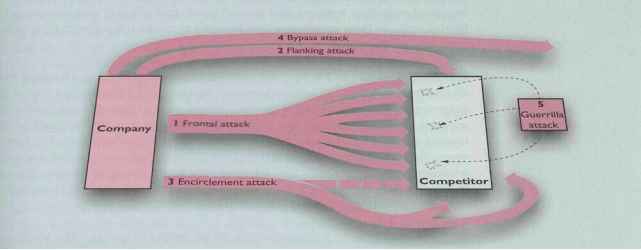Choosing an Attack Strategy
How can the market challenger best attack the chosen competitor and achieve its strategic objectives? Figure 12.6 shows five possible attack strategies.
FRONTAL ATTACK. In a full frontal attack, the challenger matches the competitor's product, advertising, price and distribution efforts. It attacks the competitor's strengths rather than its weaknesses. The outcome depends on who has the greater strength and endurance. Even great size and strength may nor be enough to challenge a firmly entrenched and resourceful competitor successfully,

- Figure 12.6
Attack strategies
Unilever has twice the world-wide sales of P & G and five times the sales of Colgate-Palmolive, hut its American subsidiary trails P & G by a wide margin in the United States. Unilever launched a full frontal assault against P & G in the detergent market while Unilever's Wisk was already the leading liquid detergent. In quick succession, it added a barrage of new products - Sunlight dishwashing detergent, Snuggle fabric softener, Surf laundry powder - and hacked them with aggressive promotion and distribution efforts, P & G spent heavily to defend its brands and held on to most of its business. It counterattacked with Liquid Tide, which came from nowhere in just 17 months to run neck-and-neek with Wisk. Unilever did gain market share, but most of it came from smaller competitors.22
If the market challenger has fewer resources than the competitor, a frontal attack makes little sense.
FLANKING ATTACK. Rather than attacking head on, the challenger can launch a flanking attack. The competitor often concentrates its resources to protect its strongest positions, but it usually has some weaker flanks. By attacking these weak spot.s, the challenger can concentrate its strength against the competitor's weakness. Flank attacks make good sense when the company has fewer resources than the competitor.
When Airbus Industries started making airliners it was up against Boeing, a company that dominates the industry. Lockheed and McDonnell Douglas had once challenged Boeing as plane makers, but Lockheed had withdrawn from the industry and McDonnell Douglas was reduced to making derivatives of its old aircraft. Airbus's first move was to develop the A300 with range and payload performance different from Boeing's established 727, 737 and 747 range.
Another flanking strategy is to find gaps that are not being filled by the industry's products, fill them and develop them into strong segments. European and Japanese car makers do not try to compete with American car makers by producing large, flashy, gas-guzzling contraptions. Instead they recognized an unserved consumer segment that wanted small, fuel-efficient cars and moved to fill this hole. To their satisfaction and Detroit's surprise, the segment grew to be a large part of die market.
ENCIRCLEMENT ATTACK. An eneirclement attack involves attacking from all directions, so that the competitor must protect its front, sides and rear at the same time. The encirclement strategy makes sense when the challenger has superior resources and believes that it can break the competitor's hold on the market quickly. An example is Seiko's attack on the watch market. For several years, Seiko has been gaining distribution in every big watch outlet and overwhelming competitors with its variety of constantly changing models. In most markets Seiko offers about 400 models, but its marketing strength is backed by the 2,300 models it makes and sells worldwide.
BYPASS ATTACK. A bypass attack is an indirect strategy. The challenger bypasses the competitor and targets easier markets. The bypass can involve diversifying into unrelated products, moving into new geographic markets or leapfrogging into new technologies to replace existing products. Technological leapfrogging is a bypass strategy used often in high-technology industries. Instead of copying the competitor's product and mounting a costly frontal attack, the challenger patiently develops the next technology. When satisfied with its superiority, it launches an attack where it has an advantage. Thus Minolta toppled Canon from die lead in the 35-min SLR camera market when it introduced its technologically advanced auto-focusing Maxxum camera. Canon's market share dropped towards 20 per cent, while Minolta's zoomed passed 30 per cent. It took Canon three years to introduce a matching technology."
G L'ERRILLA ATTAC K. A guerrilla attack is another option available to market challengers, especially smaller or poorly financed ones:
When entrepreneur Freddie Laker frontally attacked the established airlines (then BOAC and TWA) by offering cheap transatlantic flights, they fought back and bankrupted him. Now TWA has all but disappeared and British Airways is facing Virgin Atlantic run by a much wilier entrepreneur. Richard Branson. He makes guerrilla attacks on his much larger competitors. In these attacks the agile challenger typically makes small, periodic attacks to harass and demoralize the competitor, hoping eventually to establish permanent footholds. It might use selective price cuts, novel products, executive raids, intense promotional outbursts or assorted legal actions. Virgin has been successful so far and taken 22 per cent of the London to New York market. It is also expanding quickly using franchising, an approach new to the airline industry.34
Normally, guerrilla actions are by smaller firms against larger ones. The smaller firms need to be aware, however, that continuous guerrilla campaigns can be expensive and must eventually be followed by a stronger attack if the challenger wishes to 'beat' the competitor.
Continue reading here: Market Follower Strategics
Was this article helpful?
Readers' Questions
-
linda3 months ago
- Reply
-
nicole adler1 year ago
- Reply
-
frank1 year ago
- Reply
-
Tesfay1 year ago
- Reply
-
Matti Pihlava1 year ago
- Reply